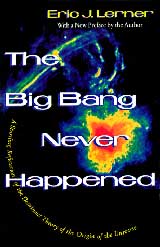Get this book
(Paperback)
(Hardcover)
About
the nature of TIME: Is it real?
Similar subjects
Science
books

The Big Bang Never Happened by Eric J. Lerner 466 pages a Book Review Next - Page 2 Mirror site
|
Get this book
(Paperback)
(Hardcover)
|
 |
Lerner lays bare some painful and embarrassing features of the Big Bang Theory. He covers the history of science in a nutshell, and ventures into other fields related to the human condition, fields that may yet be accessible to inquiry by the scientific method -- the nature of life and other self-organizing systems, Quantum Mechanics and the idea of free will, and the role of echo systems in filtering energy in a cooperative and competitive-cooperative, game-of-life, Gaia world.
Wait until you examine with Lerner his step-by-step exposition of these themes. He begins by mentioning the problems with current Cosmology, the not-so-often advertised problems of Big Bang. Here are some:
The recent COBE satellite's picture of a homogeneous, smooth background radiation (it's apparently not like "looking at the hand of God", after all, contrary to the furor in the press).
The missing matter that scientists have postulated and for which they are now searching. ("Cosmologists decided to represent the density of the universe as a ratio to the density needed to stop the expansion, a ratio they termed 'omega'. If there were just enough matter to stop the expansion, omega would equal 1. It appeared, however, that omega was really about .01 or .02 -- only a few hundredths of the matter needed to stop the expansion of the universe, and far too little to magnify the fluctuations fast enough to form galaxies.") Since this edition of Lerner's book was published, 1995 Hubble data show that so-called brown dwarf stars and smaller ones, which could have helped to supply a substantial amount of matter, do not seem exist in sufficient quantity.
The similarity of Big Bang on to the creation of Genesis, both finite in space and time, both from the void. And both, the author shows, are at odds with observation.
The author describes how the abundance of Helium, Deuterium and Lithium is at odds with observation and provides a better hypothesis.
The (usual) absence of anti-matter.
The existence of extremely large-scale structures, such as the recently, partially mapped 'Great Wall'.
|
|
|
 Fire from Ice: Searching for the Truth Behind the Cold Fusion Furor |
|
|
|
|
|
"The Big Bang Never Happened" by Eric J. Lerner.
- Part one--COSMOLOGICAL DEBATE
- A History of Creation
- The Rise of Science
- The Strange Career of Modern Cosmology
- The Spears of Odin
- The Plasma Universe
- Part Two--IMPLICATIONS
- The Endless Flow of Time
- Matter
- Infinite in Time and Space
- Cosmos and Society
- Appendix, Bibliography, Index
For more on this subject, check out John Kierein's page about Why the Big Bang is Wrong -- External Links.
Check out Bill Mitchell's book The Cult of the Big Bang: Was
There a Bang? -- You
can order it here .
What Mitchell's The Cult of the Big Bang
book is
all about.
Update by the reviewer, Jul 2007: |
Just Six Numbers:
The Deep Forces that
Shape the Universe
by Martin J. Rees
Hardcover, Paperback
Guns, Germs, and Steel:
The Fates of
Human Societiesby Jared Diamond
or Audio
Pulitzer Prize Winnerby Eric Drexler
by Seth Lloyd
Customer Review -
Love this toy, good quality and the vibrator is very powerful works great for men too gives one of the
best orgasms I've ever had
and my boyfriend loves it|
too.Links:
Is the Universe an Alien's Simulation?
About TIME
Peter Lynds -- On a Finite Universe With No Beginning or End
Kurzweil.net ... more
peterlynds.net.nz
Computers for
playing Black Jack and Roulette
Eversion:
Turning a Sphere Inside Out
A publication of TRANSLATED-CORRECTLY.COM™. All right reserved. © 2009.